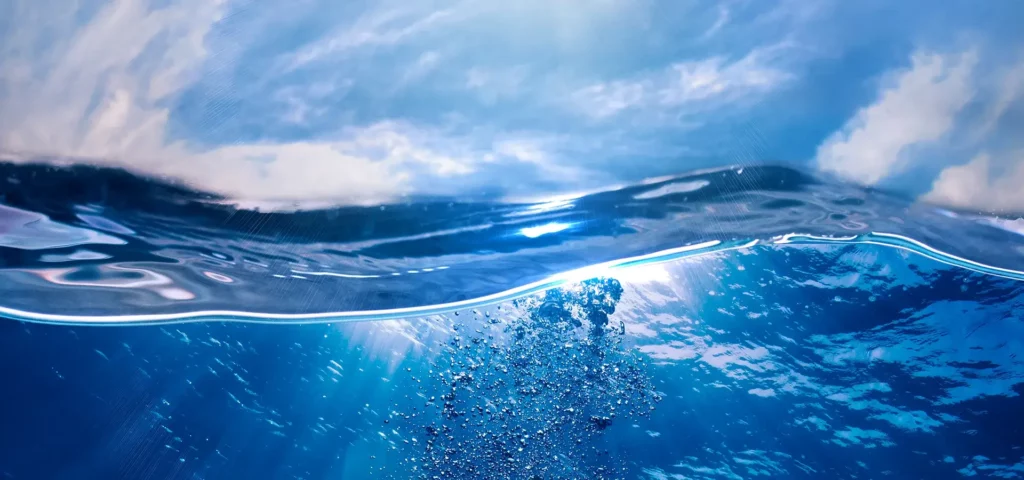This article will highlight some crucial characteristics of expansion vessel designs that are used in liquid cooling systems. The following topics will be covered:
- Coolant characteristics
- Coolant and air volume monitoring
- De-airing challenge
- Expansion vessel material considerations
- Dimensioning of the expansion vessel
1. Coolant characteristics
The temperature of the coolant in a water cooling circuit varies during the operation, which means that the volume of the fluid is not constant. The cooling system includes a lot of lines, fittings and components which all have some pressure-based flexibility. There may be some air or other gases in air pockets of a system, or some air mixed with coolant especially after filling the system. To compensate all these variations, the system must be equipped with a compensating pressure vessel which is often called “Expansion vessel”. This vessel is filled with coolant liquid and gas (air or nitrogen). The gas gives the flexibility to the cooling system. The expansion vessel supplies some coolant to the system when there is lack of it and prevents pressure loss and cavitation in the suction side of the pump. The vessel receives some coolant from the cooling circuit when the coolant temperature increases and the coolant expands. The main purpose of the expansion vessel is to keep the system pressure constant.
The expansion vessel is one of the key components of the cooling system and correctly selected high quality components ensure the reliability of the cooling system. There are principally two expansion vessel designs:
- Expansion vessels where cooling liquid and gas are in the same space
- Expansion vessels with bladders
2. Coolant and air volume monitoring
One essential requirement for a reliable cooling system is to know how much coolant there is in the system. It is easy to understand what happens when oil level in a car engine is too low. However, very few do understand the importance of the right coolant level for a cooling system functionality.
An example: a liquid cooled VFD (variable frequency drive) running electric motors:
- If the coolant level is too low, the pump will not get enough fluid
- Following this the pump may get damaged and further the cooling functionality of the variable frequency drive will be lost
- The drive protects itself and shuts down
- Without the drive the motor that has been operated stops as well.
The loss of cooling may cause a fatal safety risk or major production losses. In the worst case a ship may lose its propulsion power and ends up drifting uncontrolled.
How do different expansion vessel designs handle the coolant volume monitoring issue? An expansion vessel in which the coolant is in direct contact with the gas has several advantages:
- Expansion vessels with bladders:
- There is no way to define the coolant volume. The pressure drop indicates that something is lost and typically air is added as a solution!
- Expansion vessels where cooling liquid and gas are in the same space:
- The vessel can be equipped with visible tube – the coolant level is easy to see
- One or more level switches can be added to visible tube to give alarm(s) to control system. The amount of the coolant is under control at all times.
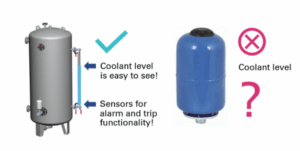
The pressure level of the cooling system may decrease with time. As there are many components, connections and pipes in the complete cooling set-up the pressure decrease may be coming from a leak in the system or from air escaping the system. Often the leaks are minimal and not easily visible. The question for the maintenance staff is then simple: should coolant or air be added to system?
- Expansion vessels with bladders: the question is difficult to answer and typically air is added!
- Expansion vessels where cooling liquid and gas are in the same space: with the coolant level indication it is easy to see, if the leak is in coolant or air and add what is needed!
3. De-airing challenge
The task of the liquid coolant is to transfer heat. The cooling capacity of the coolant is at its best when there is no air or gas mixed in it. When the cooling system is filled with coolant, air or gas mixing in the coolant can’t be avoided. This is the case in new installations and when servicing and performing system maintenance.
In addition to reduced cooling capacity the air or gas may also cause cavitation in pump impellers and unexpected behaviour of the system. These issues are even more dramatic when the coolant is a water-glycol mixture instead of pure water.
Thus, it is very important to de-air the system properly during the commissioning and after the maintenance.
Air is mixed in the coolant as very small air bubbles. These bubbles are difficult to separate from the system and de-airing may easily take several days. This is an issue especially in unexpected service cases when there is no time for long lasting processing.
As a solution, Adwatec has developed an automatic de-airing system. Together with Adwatec tank construction the de-airing happens fast and the cooling system can be taken into use quickly. The air removal continues during the operation and the air is collected to expansion vessel.
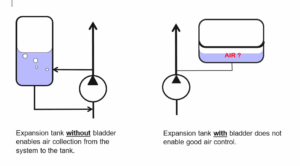
To make the process easier to follow, there is also a sight glass to the system to monitor the coolant quality visually:
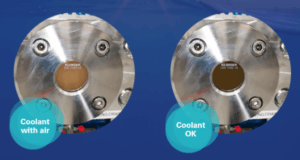
- When there is a lot of mixed air in the coolant, the view is grey and not transparent
- When the coolant is well de-aired, the view is clear and transparent
In smaller systems it takes less than half an hour and in bigger system around an hour to get small air bubbles out of the coolant. Half an hour vs. several days is a significant difference.
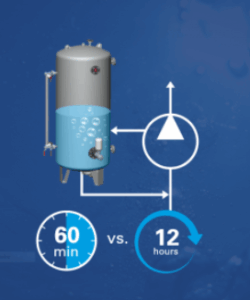 Expansion vessels with bladders:
Expansion vessels with bladders:
- De-airing is a cumbersome and slow process
- Expansion vessels where cooling liquid and gas are in the same space:
- Automatic de-airing happens fast and the cooling system can be taken into use quickly
- The air removal continues during the operation and the air is collected to expansion vessel
- Additionally the system sight glass allows visual monitoring of the de-airing process
4. Expansion vessel material considerations
To avoid galvanic corrosion in the system, carbon steel and copper-based materials must not be used, not even in fittings. For that reason, the expansion vessel should be made of stainless steel.
In small systems a vessel made of fiber-reinforced plastic is acceptable when it is equipped with needed instruments. It is light but still technically strong.
- Expansion vessels with bladders: In addition to stainless steel a rubber bag or bladder is used. The rubber as material may not withstand the use.
- Expansion vessels where cooling liquid and gas are in the same space: Stainless steel is used, no rubber or equal materials needed.
5. Dimensioning the expansion vessel
The volume of the expansion tank must be big enough for all compensation needs of the cooling system. In big systems with outdoor water-to-air heat-exchangers the volume may be hundreds of litres. The needed volume must be calculated for each case separately. The calculation must include separately the volume for coolant and gas as well as the filling pressure of the gas. The filling level of the coolant must be marked to level indicator to make it easy for maintenance personnel to make right filling.
Learn more about Adwatec water cooling solutions
WORDS: Arto Verronen, Strategist, Member of the Board
For more information please contact Ismo Lehtonen, Sales and Marketing Director
+358 40 669 2220
ismo.lehtonen@adwatec.com
Read more articles


